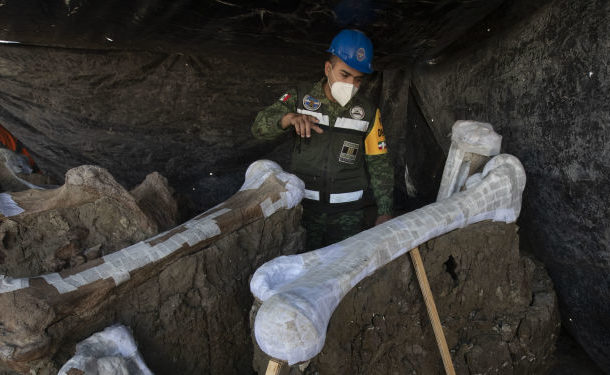Subscribe
https://cdn1.img.sputniknews.com/img/07e4/09/04/1080369821_0:0:3096:1742_1200x675_80_0_0_2d3441f849b8f1fea2b3f04bda75b6db.jpg
Sputnik International
https://cdn2.img.sputniknews.com/i/logo.png
Sputnik
https://cdn2.img.sputniknews.com/i/logo.png
https://sputniknews.com/society/202009041080369851-video-massive-collection-of-mammoth-skeletons-unearthed-at-mexican-construction-site/
Archaeologists in Mexico have discovered at least 200 mammoth skeletons at an airport construction site in Santa Lucía, north of Mexico City.
According to archeologists, there are still a large number of mammoth skeletons to be excavated. In addition, the digs have uncovered evidence that humans may have used the bones of the now-extinct animals, which died out sometime between 10,000 and 20,000 years ago, to make tools.
— SkyNews (@SkyNews) September 4, 2020
The skeletons have been found on the shores of an ancient, dried-out lake bed around 12 miles from pits dug by early human inhabitants of the area to trap mammoths.“We have about 200 mammoths, about 25 camels, five horses,” archaeologist Rubén Manzanilla López of Mexico’s National Institute of Anthropology and History told AP, referencing animals that went extinct in the Americas.
“Here we have found evidence that we have the same kind of tools, but until we can do the laboratory studies to see marks of these tools or possible tools, we can’t say we have evidence that is well-founded,” Manzanilla López added, AP reported.
According to Manzanilla López, there is some evidence to suggest that even if the mammoths at the site died due to natural causes after becoming stuck in the mud of the ancient lake bed, their remains were butchered by humans. Currently, tests are being conducted on the mammoth bones to determine if the remains were carved up by humans.Paleontologist Joaquin Arroyo Cabrales also noted that the site will become “very important” to test out hypotheses regarding the mass extinction of mammoths.
“What caused these animals' extinction, everywhere there is a debate, whether it was climate change or the presence of humans,” Arroyo Cabrales told AP. “I think in the end the decision will be that there was a synergy effect between climate change and human presence.”
Ashley Leger, a paleontologist at the California-based Cogstone Resource Management company who was not involved in the excavation, noted that such natural death groupings of animals are rare.
“A very specific set of conditions that allow for a collection of remains in an area but also be preserved as fossils must be met. There needs to be a means for them to be buried rapidly and experience low oxygen levels,” she noted.According to National Geographic, mammoths were similar in size to elephants but had narrower skulls, smaller ears, shorter tails and, of course, lots of hair
TrackDo not trackCommunity standardsDiscussion
- Сomment
-
Post limit reached. Please try again in a minute.
-
Your comment contains a link, so it can't be published on our site
All comments
Show more comments (20)
- Сomment
-
Reply

in reply to(Show commentHide comment)
| | Edit | Delete
Save
Thank you! Your comment will be reviewed by the moderator for compliance with the RulesSource: sputniknews.com



Comments